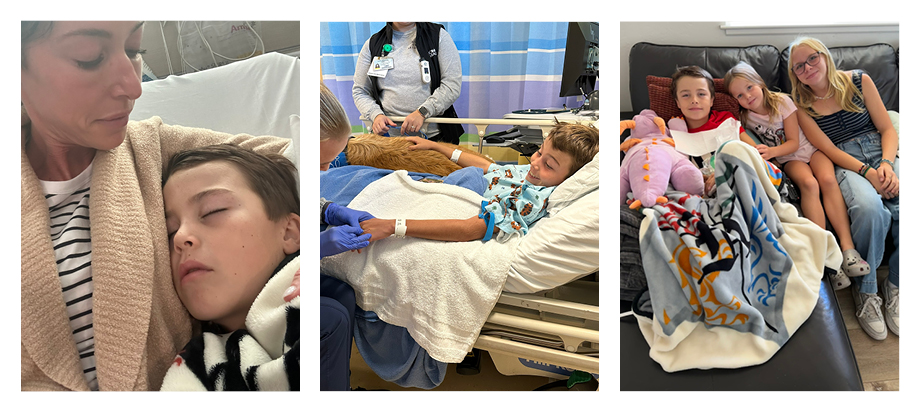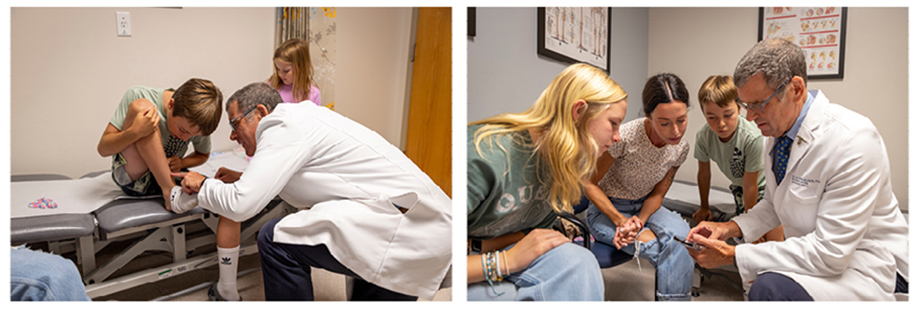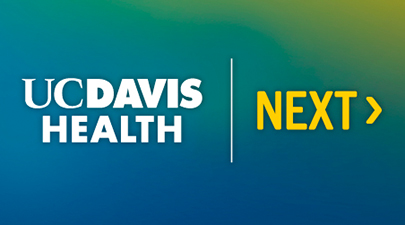Minimally invasive ablation treats osteoid osteoma in young athlete
Ryder Phippin of Auburn is one determined kid. A tackle football player since the age of 6, he always took the hits in stride.
“He’s the toughest kid I know,” said Jennifer Phippin, Ryder’s mom.
At 8 years old, Ryder became his team’s starting quarterback. During a game in November 2023, he got hit hard.

“He went down and a kid landed on his leg. The medics checked him out because his leg was hurting really badly.”
Ryder’s leg pain continued intermittently. His parents took him to see a doctor a couple months later.
Diagnosis pending
The doctor figured Ryder’s injury was most likely a calcified contusion, a condition where bone tissue forms within a muscle after a bruise. He recommended rest, ice and physical therapy.
“He told us it would just go away eventually,” Jennifer said. But it kept getting worse.
By this time, Ryder was in excruciating pain, especially at night. On a return visit to the doctor, the medical team took an X-ray and the results were alarming.
“It was a surreal moment,” Jennifer said, recalling how she heard the doctor say the words osteoid osteoma.
An osteoid osteoma is a benign bone tumor that is often characterized by injury to the area where the tumor occurs. The main symptom is pain which often gets worse at night.
Ryder needed a pediatric orthopaedist. He was connected to R. Lor Randall, a renowned pediatric surgeon and oncologist and also the chair of the Department of Orthopaedic Surgery at UC Davis Health.
Expert orthopaedic care
“Osteoid osteomas aren't typically that large, but his tumor was very large, over a centimeter and growing,” Jennifer recalled the doctor explaining. “He also said the tumor wasn't showing up on the X-ray like a normal osteoid osteoma does.”
Despite the challenges, Randall assured the Phippins he could likely perform a CT-guided radiofrequency ablation, a modern procedure that burns out the tumor.
“Originally, these tumors were treated with an aggressive surgical removal of a portion of the bone which has some real risks and a long recovery. Ryder's bone tumor was amenable to a minimally invasive technology that enables return to activity quickly,” Randall said. “While we have been using this technology for years, our orthopaedic team was one of the first to embrace and popularize its use.”
First, though, Randall wanted to confirm the diagnosis and explain the treatment plan to the family.
“He said that if it was an osteoid osteoma, medications like ibuprofen would take away the pain, so we had to do a couple weeks of ibuprofen therapy,” Jennifer said. “It helped greatly. I was so relieved and appreciated that Dr. Randall wanted to be 100% certain in his diagnosis. Because if it did turn out to be some form of cancer, he didn't want to miss it.”
Specialized treatment
Ryder underwent surgery in August 2024.
“We percutaneously ablated with a probe using advanced imaging techniques. Interventional radiologists, as well as orthopaedic surgeons perform this procedure,” Randall said. “We were the first to perform this in the western United States years ago at my prior institution. The advantage of the surgeon performing the procedure is that we follow these patients afterwards and can address any additional issues that arise from the tumor or treatment.”
The procedure was a success.
“The experience was wonderful,” Jennifer said. “Obviously, we have been to other facilities and UC Davis treated him so well.”

UC Davis Children’s Hospital is well-known for making children feel comfortable on the worst days of their life with the help of the Child Life and Creative Arts Therapy Department, as well as specially trained dogs that provide support to young patients. Jennifer was thoroughly impressed. “I mean, he got to play video games and cuddle the dog. It was the highlight of his day. We still talk about it.”
Ryder left the hospital with a couple stitches and a bulky walking boot which he had for about six weeks. Recovery was hard on the young and active boy: Ryder would need to sit out the 2024 football season. But soon after, he was cleared for sports and started basketball season.
“If it had been a traditional bone surgery, he would've been out for much longer, so I was very grateful to have something relatively quick and easy,” Jennifer said.
Because the tumor was abnormally large, the Phippins worried about the potential for recurrence. But so far, all the X-rays have shown no signs of a tumor. At his most recent scan, Ryder got a clean bill of health — as well as orders from Randall to help his mom around the house and do his homework.
“All of the follow-up appointments with Dr. Randall have been great. Although Ryder’s case was fortunately not a difficult one compared to what Dr. Randall usually handles, I never felt like Ryder was less important to him,” Jennifer said. “He made him feel so good the whole time.”

Now, this all-around sports guy is back to doing what he loves, including basketball, baseball, jiujitsu, swimming, archery, horseback riding and, of course, football. Ryder can’t wait for the upcoming season. In addition, his mom says her little “wild man” is really smart, enjoys math and reading and wants to be a machinist like his dad. An avid Disneyland fan, Ryder trekked around the happiest place on earth in his boot and didn’t miss a beat.
“I'm very grateful for that procedure because it was minimally invasive and the downtime wasn't that long in the grand scheme of things,” Jennifer said. “Ryder is healthy and back to doing the things he loves and we have Dr. Randall and UC Davis Children’s Hospital to thank for that.”
Related Resources
- UC Davis Health providers also use radiofrequency ablation to treat other conditions in adults, including thyroid nodules. Learn more about thyroid nodule ablation.
- Nonsurgical procedure brings relief to those with thyroid nodules





